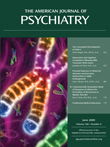Randomized, Double-Blind, Placebo-Controlled Study of Paliperidone Extended-Release and Quetiapine in Inpatients With Recently Exacerbated Schizophrenia
Abstract
Objective: The authors compared paliperidone extended-release and quetiapine in patients with recently exacerbated schizophrenia requiring hospitalization. Method: In a 6-week double-blind study, inpatients with a recent exacerbation of schizophrenia were randomly assigned to treatment with paliperidone extended-release, quetiapine, or placebo. A 2-week monotherapy phase was followed by a 4-week additive-therapy phase. Target doses were at the upper end of recommended ranges: paliperidone extended-release, 9 or 12 mg/day, and quetiapine, 600 or 800 mg/day. The primary endpoint was the difference in mean total change score on the Positive and Negative Syndrome Scale (PANSS) between paliperidone extended-release and quetiapine at the 2-week monotherapy phase endpoint. Results: Six-week completion rates were 77.5% (124/160) with paliperidone extended-release, 66.7% (106/159) quetiapine, and 63.8% (51/80) placebo. Improvement in mean PANSS total change score was greater with paliperidone extended-release than with quetiapine from day 5 (–11.4 versus –8.2) through the monotherapy phase endpoint (–23.4 versus –17.1). Only paliperidone extended-release showed significantly greater PANSS improvement compared with placebo at 2 weeks. At the 6-week study endpoint, there was a significantly greater improvement with paliperidone extended-release compared with quetiapine despite similar use of additive therapy (predominantly other antipsychotics). Common adverse events with paliperidone extended-release, quetiapine, and placebo, respectively, were tremor (13.9%, 5.0%, 7.5%), somnolence (8.9%, 11.9%, 1.3%), insomnia (10.1%, 9.4%, 11.3%), and headache (12.0%, 7.5%, 13.8%). Six-week adverse event-related discontinuation rates were 6.3%, 10.1%, and 6.3%, respectively, in the paliperidone extended-release, quetiapine, and placebo groups. Conclusions: Compared with quetiapine, paliperidone extended-release improved symptoms earlier and to a greater degree in patients with recently exacerbated schizophrenia requiring hospitalization, with no unexpected tolerability findings.



